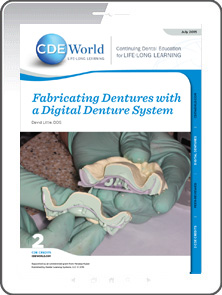CDEWorld > eBooks > Fabricating Dentures with a Digital Denture System


ADA CERP is a service of the American Dental Association to assist dental professionals in identifying quality providers of continuing dental education. ADA CERP does not approve or endorse individual courses or instructors, nor does it imply acceptance of credit house by boards of dentistry. Concerns or complaints about a CE provider may be directed to the provider or to ADA CERP at www.ada.org/cerp/

Approved PACE Program Provider. FAGD/MAGD credit. Approval does not imply acceptance by a state or provincial board of dentistry, or AGD endorsement. 1/1/2023 to 12/31/2028. ID # 209722.
eBook
Released: Monday, August 10, 2015
Expires: Tuesday, July 31, 2018
Fabricating Dentures with a Digital Denture System
By David Little, DDS
Commercial Supporter: Kulzer
Conventional denture-fabrication techniques have changed little for decades, despite having the disadvantages of being complicated, time-consuming, and susceptible to errors. Recently, however, CAD/CAM and rapid-prototyping tools have been introduced that enable the digital design of dentures. This article reviews the workflow involved in fabricating dentures with one of the new digital denture systems and summarizes the advantages of this approach.
LEARNING OBJECTIVES:
-
Review the evolution of CAD/CAM technology as applied to dentistry.
-
Understand the process of taking the impression and bite registration using a digital denture system.
-
Summarize the advantages of designing dentures with digital tools.
About the Author
Dr. Little is a national and international speaker, professor, and author. A graduate of the University of Texas Health Science Center at San Antonio Dental School, he has a multidisciplinary, state-of-the-art dental practice in San Antonio, and he is also a clinical researcher focusing on implants, laser surgery, and dental materials.
Download FREE eBook now!

